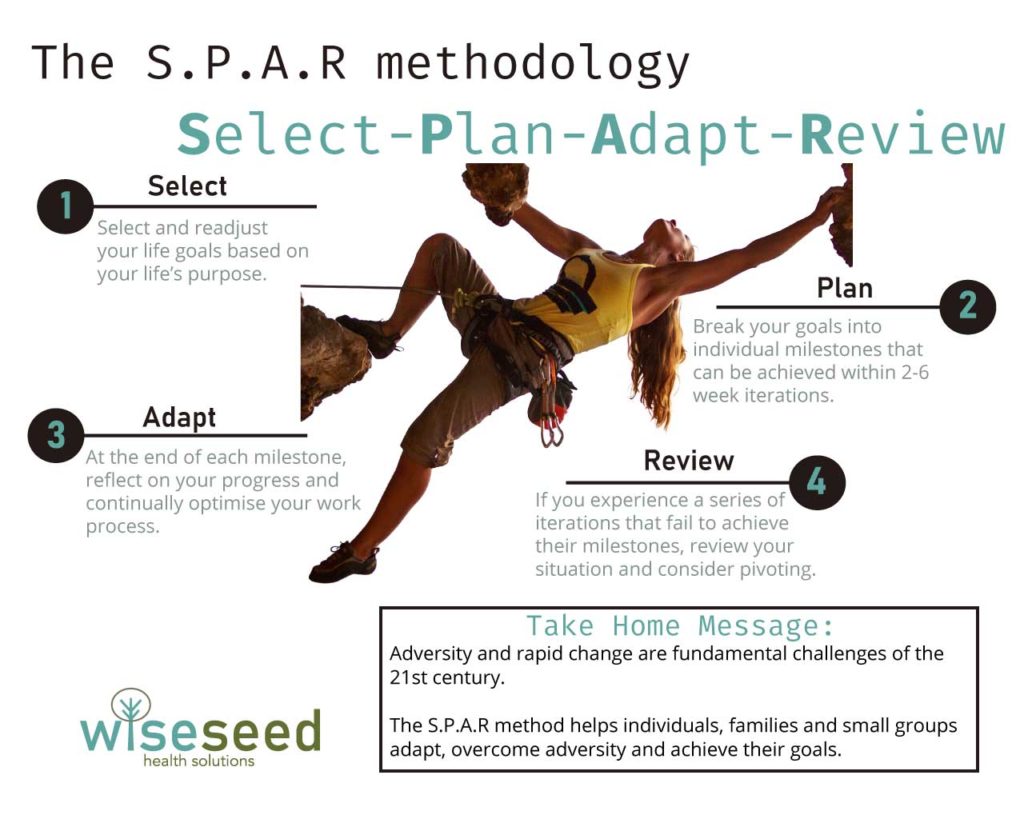Overcoming Adversity and Rapid Change

Adversity and Rapid Change are the New Normal
At the risk of massively understating things, we think that the world is going through an incredibly challenging time.
It’s not just the unfolding consequences of the COVID-19 pandemic for the economy and our way of life. There’s also the alarming backdrop of political unrest, inequality, poor community health, and a collective concern about where society is heading. Adding further uncertainty is the ongoing technological tsunami, which includes the frightening implications of machine learning, the disruptive power of social media, and the ever-increasing automation of our workplace.
With everything that is going on, it’s easy to become distracted and lose focus on your life purpose and goals. If you don’t intentionally work to stay focused, you risk being swept along in a state of reactive fear and outrage. This makes you far less resilient, as you won’t be at your best to proactively face the next wave of adversity and change that’s coming your way.
When faced with ongoing adversity, you must develop a mental framework to make sense of chaotic situations and remain goal-orientated. Also, during times of rapid change, you need to remain agile in your thinking to quickly adapt to new developments.
Being inflexible and dogmatic in your approach makes you vulnerable when things beyond your control change the world around you, or create a new context that may make your goals irrelevant or reduced in value.
This article outlines a simple yet powerful framework that can help you overcome adversity and rapid change to realise your life goals.
The SPAR Methodology
At Wise Seed, we use the SPAR methodology when planning our personal and business goals. This approach integrates two well-established approaches that have a proven track record of success: the Selection Optimisation and Compensation (SOC) framework (1), and Agile Methodology (2).
The SOC Framework
We’ve previously discussed the importance and value of this framework in our Five Pillars of Successful Aging article. The SOC system was designed to help people live successful lives despite having access to limited resources and facing adverse life events such as old age or illness (3).
The SOC system focuses on helping people identify and select life goals, deploying the most effective strategies for achieving these, and providing approaches that allow an individual to achieve their goals despite setbacks and adversity (3). We like the SOC approach because of the strong evidence-base supporting it’s use and because it can be readily applied. But we have incorporated an additional element – Agility – because there is a desperate need to be adaptive in responding to the rapid change that we see around us.
Agile Methodology
Agile methodologies were invented by software developers to adapt and thrive within the turbulent and ever-changing hi-tech corporate environment (2). In this context, agile methods aggressively embrace rapid change and are proactively growth-oriented (4). Agile methodology has been further tested and refined in the cut and thrust of corporate America (5).
There are two general principles from the agile philosophy applicable to the SPAR methodology:
1 Adaptation. Agile methods are designed to be highly adaptive by incorporating feedback mechanisms that allow you to quickly adapt in rapidly changing environments.
2 Iteration and incremental change. The heart and soul of agile methodology is the application of rapid iterations combined with small, incremental changes in real-time.
We think the inclusion of the agile concept into a model is critical, as it builds a mental framework that allows you to engage with rapid change in a business-as-usual manner. This is essential if you want to keep moving forward during times of continuous change.
Putting SOC and Agile Methods Together: The SPAR Methodology
In our view, assimilating the SOC framework with the agile approach creates a model with four steps:
Selection
Planning
Adaptation
Review
Each of the components is summarised below:
Step 1: Selection
Selection begins with the identification and, when required, the readjustment of individual life goals to accommodate the ebbs and flows that naturally occur throughout life. Life goal selection can be proactive or reactive depending on circumstance. For example, you can proactively select the life goals you are going to achieve after retirement, or you can reactively adjust your life goals in the face of abrupt and unexpected disease diagnosis (3).
The essence of effective goal selection lies in having an underlying purpose or mission that informs your goal setting, an ability to accurately assess your objective reality, and the willingness to adjust your goals to meet this objective reality head-on.
Think long and hard about your goals. Meaningful goals help build a meaningful life.
Step 2: Planning

The planning stage has one critical purpose: breaking down your goals into a series of achievable milestones. This is essential, because these milestones become the foundation of the iterative approach outlined in Step 3.
Sounds simple right? But keep in mind that how well you break down your overall goals into simple, achievable milestones will have a huge influence on whether you succeed or fail. So, make sure you do the necessary work at this critical stage to set yourself up for success.
Step 3: Adaptation
Being able to make small, simple changes in real-time is the essence of rapid adaptation. The million-dollar question is, how do you achieve this in your everyday life?
First, determine the shortest time-period that is required to achieve your first milestone. The consensus that has emerged from proven methodologies is that iterations of between 2-6 weeks work well. To rapidly adapt to change, shorter iterations are better.
This is your very first iteration. Now get to work!
At the end of your first iteration, carefully reflect on your progress. Did you achieve your desired outcome? If you did, take careful note of which processes worked and which did not. Always be on the lookout for new technologies or methods which may improve the efficiency of your process. Be thorough – if you didn’t achieve the desired outcome, why not?
Based on this reflection, update your methods. This positive feedback approach allows you to optimise finite resources so that you can achieve your goals as efficiently as possible (3).
Here, optimisation is the act of strategically deploying available resources towards achieving your milestones. The overall purpose of optimisation is to maximise your finite resources so that you can achieve your goals as efficiently as possible (3).
Some strategies that you could consider at this stage include re-prioritising tasks and resources, scheduling appropriate time allocation to tasks, becoming more efficient and persistent in your efforts, integrating new methods and technologies, and refocusing your attention on people who really matter, such as family and close friends.
This marks the end of your first iteration. Now it is time to get busy on your second iteration!
It is repeatedly achieving milestones using short iterations, followed by analysis and subsequent positive feedback, that allows you to adapt and thrive in turbulent times.
Step 4: Review (and pivot if necessary)
No matter how carefully you plan and how effectively you execute, sometimes the Universe throws you a curveball. If this happens, you may need to pivot.
Reviewing your goals may be called for when your physical, mental, or social resources drop below the level required to achieve a specific goal. Pivoting may also be required if you are suddenly crushed by some random event outside of your control.
The unexpected catastrophe is an obvious time to seriously consider pivoting. However, in less extreme circumstances, making the call to pivot is very difficult. For example, if you are breaking even with a business product but not progressing towards a profit, how long do you persist before you pull the pin and pivot to a new approach? Usually, there are no easy answers to this question.
This is where adopting an agile methodology may help. If you are constantly iterating, adapting, and re-iterating and yet still failing to move forward, it’s possible that you are trapped in a futile cycle. In this scenario, a string of failed iterations represents a definite red flag telling you that it’s time to review your progress and perhaps consider pivoting.
If you do decide to pivot, what form should your pivot take? This is not a simple question as there are many ways of dealing with an impasse. For example, you could reduce the scope of your original plans and pursue a more modest and readily achievable goal. Alternatively, you could put the project on hold and focus on building up capital, be it monetary, social, or both. Or, as an extreme option, you may be required to undertake the heroic effort of radically refocusing your efforts onto something entirely different.
Always remember, abandoning a life goal and pivoting in a new direction can fill you with self-doubt, fear and anxiety. Pivoting is never an easy decision, but it is often essential to survive. So, if you make the call to pivot, commit. Go back to step one, reset your goals and then get back to work.
Conclusion
Being able to adapt and thrive during times of adversity and rapid change requires a mental framework suitably calibrated to these two conditions. To this effect, we use and recommend the SPAR framework when planning our personal and business goals because it:
– is orientated to defining your real purpose
– encourages you to systemically plan towards achieving this purpose
– facilitates your rapid responses to changes in the environment
– forces you to continually review how best to move forward
SPAR offers an approach that you can use in your own life and – once practised – can quickly become a key component of resilient living.
[Note that this is a summary to help you understand the SPAR approach and start to think about how you can use it. We’ll provide a lot more detail along with the research underpinning the framework in a future subscriber newsletter.]

References and Further Reading
1. M. M. Baltes, L. L. Carstensen, The process of successful ageing. Ageing & Society 16, 397-422 (1996).
2. M. Fowler, J. Highsmith, The agile manifesto. Software Development 9, 28-35 (2001).
3. B. B. Baltes, C. W. Rudolph, The theory of selection, optimization, and compensation. The Oxford handbook of retirement, 88-101 (2012).
4. S. L. Goldman, R. N. Nagel, K. Preiss, Agile competitors and virtual organizations: strategies for enriching the customer. (Van Nostrand Reinhold New York, 1995), vol. 8.
5. J. Highsmith, A. Cockburn, Agile software development: The business of innovation. Computer 34, 120-127 (2001).
Disclaimer
The material displayed on this website is provided without any guarantees, conditions or warranties as to its accuracy.
Information written and expressed on this website is for education purposes and interest only. It is not intended to replace advice from your medical or healthcare professional.
You are encouraged to make your own health care choices based on your own research and in conjunction with your qualified practitioner.
The information provided on this website is not intended to provide a diagnosis, treatment or cure for any diseases. You should seek medical attention before undertaking any diet, exercise, other health program or other procedure described on this website. To the fullest extent permitted by law we hereby expressly exclude all warranties and other terms which might otherwise be implied by statute, common law or the law of equity and must not be liable for any damages whatsoever, including but without limitation to any direct, indirect, special, consequential, punitive or incidental damages, or damages for loss of use, profits, data or other intangibles, damage to goodwill or reputation, injury or death, or the cost of procurement of substitute goods and services, arising out of or related to the use, inability to use, performance or failures of this website or any linked sites and any materials or information posted on those sites, irrespective of whether such damages were foreseeable or arise in contract, tort, equity, restitution, by statute, at common law or otherwise.

Ten Minutes is All You Need
Research has shown that ten minutes of moderate-to-vigorous exercise performed each day is enough to significantly reduce your risk of early death.

The Spirit Domain of Everyday Resilience
In this article we consider how to employ the inherently emotional side of your nature (your ‘Spirit’) and harness its energy towards enhancing your everyday resilience.




